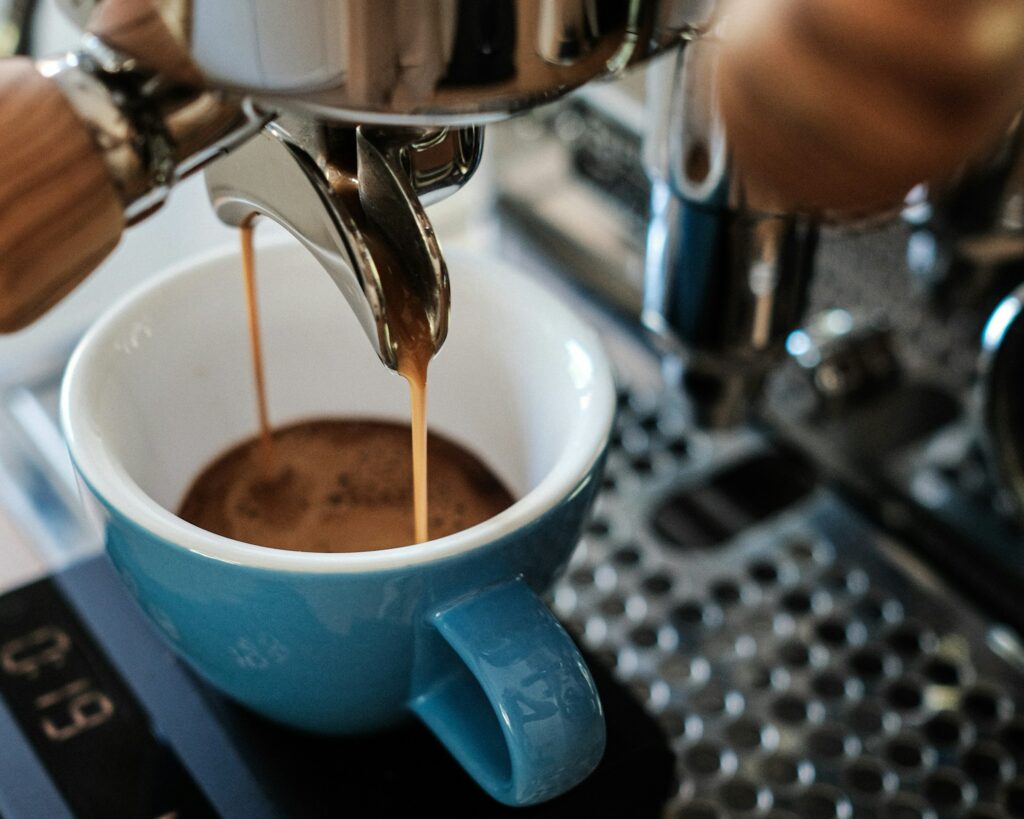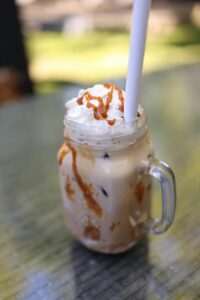Some people think “strong coffee” just means bitter coffee. That’s like saying hot sauce is only about the burn, but it misses the point.
Strength can mean two things: a bold, in-your-face flavor or a real caffeine jolt that gets your heart racing. Sometimes it’s both, depending on how you brew.
In this post, we’ll break down the best methods for making coffee that packs a serious punch.
Whether you crave flavor that slaps or caffeine that kicks, you’ll find the brew that hits your sweet spot!
What Makes Coffee “Strong”?
When people talk about “strong coffee,” they often mix up three very different ideas: strength, flavor, and caffeine.
Strength usually refers to how concentrated the brew feels on your tongue, flavor is about the richness and depth of taste, and caffeine is the actual chemical kick that wakes you up.
You could have a cup that tastes bold but doesn’t pack much caffeine, or one that’s loaded with caffeine yet surprisingly smooth.
What determines the outcome? Several factors—your beans, grind size, water-to-coffee ratio, and, most importantly, the brewing method.
A dark roast might taste intense, but lighter roasts often carry more caffeine. A fine grind extracts fast and heavy, while a coarse grind tends to be milder.
Ratios matter too: more coffee to less water equals more punch, no matter the roast. But the real game-changer is how you brew it.
A French press lets the grounds steep and extract oils for body, while espresso relies on pressure for concentration. Cold brew, on the other hand, trades sharp edges for smooth, caffeine-heavy results.
In short, brewing isn’t just the last step, but it’s the steering wheel that decides whether your cup whispers, sings, or shouts.
1. Espresso: The Classic Powerhouse
Espresso is the heavyweight champion of the coffee world, and it earns that title for good reason.
To make it, hot water is forced through a bed of very finely ground coffee at high pressure in just 25–30 seconds.
That short brew time and intense pressure create a small but mighty shot that’s rich, concentrated, and layered with crema—the golden foam on top that signals a well-pulled shot.
This process doesn’t just make coffee stronger in taste; it also sets the standard that other brewing methods are compared to when people talk about “strong” coffee.
The appeal of espresso goes beyond its boldness. It’s quick, taking less than a minute once your machine is ready, and it’s incredibly versatile.
You can sip it straight for that sharp, eye-opening hit, or use it as the base for lattes, cappuccinos, and pretty much every other café drink. That said, it’s not without drawbacks.
To get authentic espresso at home, you need specialized gear like an espresso machine and often a grinder capable of producing ultra-fine grounds.
Both can be expensive, and the learning curve is steeper than other methods.
Still, if you want concentrated flavor and the kind of coffee that packs a punch with minimal volume, espresso is the gold standard.
2. Moka Pot (Stovetop Espresso)
If espresso is the flashy sports car of the coffee world, the Moka pot is the reliable hatchback that gets you surprisingly far without draining your wallet.
This little stovetop brewer, often found in Italian kitchens, uses steam pressure to push hot water through finely ground coffee.
The result is a strong, concentrated cup that feels espresso-like, even if it doesn’t quite hit the same intensity.
It’s compact, affordable, and practically indestructible, which makes it a favorite for anyone who wants strong coffee at home without investing in a pricey machine.
In terms of strength, a Moka pot lands somewhere between drip coffee and true espresso.
The flavor is bold, with more body than your average brew, but it won’t carry the same crema or intensity as a proper espresso shot.
Still, it satisfies that craving for a robust kick, especially if you like your coffee dark and punchy.
It’s perfect for budget-conscious coffee lovers, small kitchens, or even camping trips—just a stove (or fire) and you’re good to go.
Want to take it up a notch? Use a finer grind (but not too fine, or you’ll clog it), preheat your water to speed up brewing, and keep the heat low to avoid scorching the grounds.
For an extra kick, try blending in beans with naturally higher caffeine, like robusta, or simply shorten your water fill to concentrate the flavor.
With a few tweaks, the humble Moka pot can deliver a cup that punches well above its weight class.
3. French Press
The French press is all about immersion brewing, which means the coffee grounds sit and steep directly in hot water.
This method pulls out the oils and tiny particles that most paper filters leave behind, giving the brew a full-bodied, bold flavor that feels heavier on the tongue.
Because everything stays in contact during the steep, you end up with a cup that’s rich, strong, and sometimes a little rustic.
It’s the kind of coffee that makes you feel like you’re getting the “whole bean experience,” not just a filtered version of it.
One big factor with the French press is steep time. Let it sit for four minutes, and you’ll get a strong but balanced cup.
Push it to six or seven, and the flavor becomes much more intense—sometimes crossing into bitterness if you’re not careful.
That’s both the beauty and the danger of this method: you control the dial, but you can also turn it too far.
Its pros are hard to ignore. The French press is simple to use, affordable, and can brew enough coffee for a crowd. No filters, no complicated gear—just grounds, hot water, and a plunger.
On the flip side, the same immersion that gives it body can also make it taste muddy or bitter if you use the wrong grind or steep too long.
A coarse grind helps prevent over-extraction, while experimenting with time lets you dial in your preferred level of strength. Want it bolder? Steep a bit longer or add a touch more coffee.
Want it smoother? Shorten the brew time slightly. It’s flexible, forgiving, and perfect for anyone who likes coffee with muscle.
4. AeroPress
The AeroPress is a curious little gadget that looks more like a science experiment than a coffee maker, but don’t let its simple plastic design fool you.
It’s a pressure + immersion hybrid, meaning it combines the full-bodied steeping of a French press with the concentrated push of espresso.
You stir the grounds in hot water, then press them through a paper or metal filter using gentle pressure.
The result is a smooth, strong cup with low bitterness and plenty of room to tweak to your liking.
Coffee geeks adore the AeroPress because it can mimic “espresso-style” shots without needing a machine that costs as much as a month’s rent.
It won’t give you that textbook crema on top, but the flavor concentration is bold and satisfying.
And the beauty lies in its flexibility because you can brew a small, punchy shot to sip straight or dilute it with hot water to make an Americano.
The pros are easy to love. It’s lightweight, durable, and so portable you can toss it in a backpack and take it camping. Cleanup is quick, it doesn’t rely on electricity, and it invites endless experimentation.
The cons? Some purists might argue it’s not “real” espresso, but that’s splitting hairs. What you get is tasty, strong coffee without fuss.
To maximize strength, there are a few tricks AeroPress fans swear by.
Use a fine grind, shorten the water-to-coffee ratio, and try the inverted method—where you flip the brewer upside down, steep a little longer, then plunge.
This keeps water from dripping out too early and lets you squeeze out a thicker, more concentrated cup. With the AeroPress, half the fun is tinkering, and the other half is sipping the rewards.
5. Turkish Coffee
Turkish coffee isn’t just a drink, but it’s an experience.
The process starts with an ultra-fine grind, almost like powder, that’s stirred directly into water and sugar (if desired) inside a small pot called a cezve or ibrik.
Unlike most methods, nothing gets filtered out. The coffee simmers slowly until it foams, then it’s poured straight into the cup, grounds and all.
The result is a thick, unfiltered brew that delivers a hit of both flavor and caffeine in a tiny serving. It’s not just strong, but it’s unapologetically intense.
What makes Turkish coffee so powerful is that combination of ultra-fine grind and full extraction.
You’re literally drinking the coffee in its most concentrated form, which means every sip is dense, aromatic, and buzzing with caffeine. Many cultures also embrace the ritual around it.
From reading fortunes in the leftover grounds to serving it as a symbol of hospitality, Turkish coffee carries a cultural weight that turns a cup into a moment.
The pros are obvious if you enjoy strong, ritualistic coffee. It’s rich, flavorful, and steeped in tradition, offering an experience that goes beyond the drink itself.
But the same thing that makes it unique can also be a turn-off. The unfiltered grounds create a gritty texture at the bottom of the cup, which isn’t for everyone.
Some people love the earthy punch, while others find it overwhelming.
Either way, Turkish coffee is one of the boldest ways to brew, and if you want coffee that doesn’t whisper but shouts from the rooftops, this is it!
6. Cold Brew Concentrate
Cold brew often gets labeled as “too smooth” to be strong, but that’s a big misconception.
Smooth doesn’t mean weak—it just means the acids and bitterness are dialed down because the coffee is extracted slowly with cold water instead of hot.
Under the surface, cold brew concentrate is a caffeine bomb.
Since it’s brewed with a high coffee-to-water ratio and steeped for 12–24 hours, the result is a dense concentrate that can easily outdo a regular hot brew in terms of caffeine per sip.
The beauty of cold brew concentrate lies in its flexibility. Make a big batch, stash it in the fridge, and you’ve got strong coffee ready to go all week.
It’s versatile too because you can drink it over ice, dilute it with water, pour it over milk, or even heat it up for a hot cup without losing its strength.
That convenience and smooth flavor are why so many people swear by it, especially in summer.
Of course, there are trade-offs. The biggest downside is the wait because you can’t exactly decide you want cold brew and have it five minutes later.
It takes patience, and if you cut corners, you’ll notice the difference.
To really maximize strength, play with your ratios: use more coffee grounds for a bolder concentrate, or even make a double concentrate if you want a serious kick.
Just remember, with cold brew concentrate, you’re not just making coffee, but you’re brewing a caffeine arsenal that can be deployed any way you like.
7. Percolator (Old-School Strong)
The percolator is like the tough old cowboy of coffee brewing—rugged, no-nonsense, and unapologetically bold.
It works by cycling boiling water up through a tube and letting it drip repeatedly over the coffee grounds.
This continuous percolation extracts more and more from the beans, which is why the result often tastes stronger than drip coffee.
But here’s the catch: that same process can easily lead to over-extraction, leaving you with a brew that’s as bitter as it is bold.
Despite its flaws, plenty of people still swear by the percolator.
Campers love it because it’s virtually indestructible, doesn’t need electricity, and feels nostalgic—like a cup of strength brewed right on the fire.
Strong-coffee lovers appreciate its intensity too, because when done right, a percolator produces a hearty, full-bodied drink that packs a punch like few others.
It’s not subtle, but then again, neither is sitting around a campfire with a tin mug in hand.
If you want to avoid bitterness, timing and heat are everything. Don’t let it boil endlessly, and once the coffee has perked through enough times, take it off the heat.
Using a coarser grind can also help prevent harsh flavors, since finer grounds over-extract more quickly.
And if you want a smoother cup without losing strength, keep a closer eye on the process instead of letting it run on autopilot.
The percolator may be old-school, but with the right touch, it can still brew a cup that’s strong, nostalgic, and surprisingly satisfying!
How to Maximize Strength in Any Method
Coffee-to-Water Ratio
The easiest way to boost strength is by adjusting how much coffee you use. The “golden ratio” is around 1 to 2 tablespoons of coffee per 6 ounces of water, but rules are made to be bent.
Add more grounds and you’ll get a bolder, more concentrated brew. Just keep in mind—push it too far and your cup may taste more like jet fuel than breakfast coffee.
Grind Size Tweaks
Grind size changes everything. A finer grind means more surface area, faster extraction, and a stronger flavor.
But too fine, and you risk bitterness or even clogging your brewer, especially with a French press or Moka pot.
A coarser grind will mellow things out and smooth the flavor, so experiment until you find the balance that matches your taste buds.
Roast Choice
Dark roasts taste bold, smoky, and intense, which is why people often assume they’re “stronger.” But light roasts actually hold more caffeine since they’re roasted for less time.
So if you want flavor that hits like a hammer, go dark. If you want the biggest caffeine buzz, light or medium roasts paired with the right brewing method will do the trick.
Brew Time Adjustments
The longer coffee brews, the more it extracts, which can increase strength—but also bitterness if you’re not careful.
With immersion methods like the French press, a few extra minutes can push your cup from rich to harsh. With fast methods like espresso or AeroPress, even seconds make a difference.
Final Words
Strong coffee isn’t one-size-fits-all.
Each brewing method brings its own kind of muscle—espresso is sharp and concentrated, French press is bold and heavy, cold brew is smooth but sneaky with caffeine.
The trick is figuring out what kind of “strong” you actually enjoy. Play around, tweak the grind, adjust the ratio, and see what sticks.
Here’s a fun challenge: brew the same beans with two different methods and taste them side by side.
You’ll be surprised how one bag of coffee can shout in one cup and sing in another!
FAQs
Which method has the most caffeine per cup?
Cold brew concentrate usually wins in total caffeine, especially if you drink it straight.
But if you’re going by volume, drip coffee often has more caffeine per serving than espresso because the serving size is bigger.
Is dark roast always stronger?
Not necessarily. Dark roasts taste bolder and smokier, which tricks people into thinking they’re stronger.
Light roasts actually keep more caffeine since they’re roasted for less time.
Can you make strong coffee without special gear?
Absolutely. A simple French press, a Moka pot, or even just tweaking your ratios in a regular drip machine can deliver a strong cup. You don’t need a fancy espresso machine to feel the kick.
Does grind size really make a difference?
Yes, massively. Finer grinds extract faster and give you a stronger, more concentrated flavor.
Coarser grinds slow things down, making the taste smoother but less intense. It’s like adjusting the volume knob on your coffee.
Which method tastes strongest vs. feels strongest (caffeine hit)?
Espresso usually tastes the strongest because of its concentrated flavor. Cold brew concentrate often feels the strongest because of the sheer caffeine load.
One smacks your taste buds, the other sneaks up and powers your whole day.



